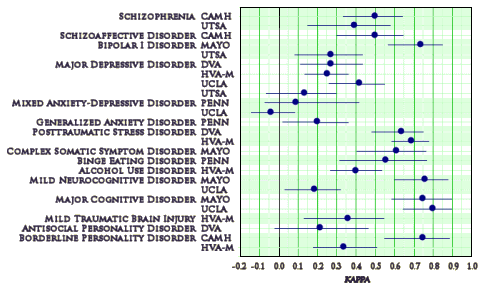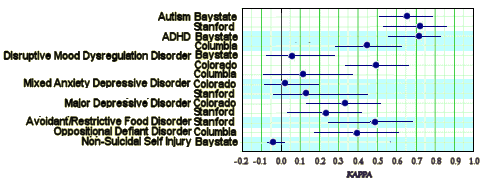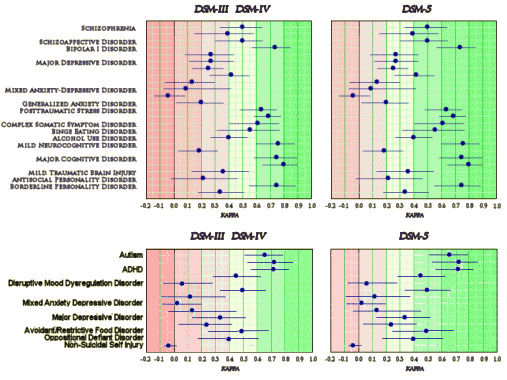

- The Task Force cancelling one of the two planned sets of Field Trials
- The actual interpretations of the kappa values
- Whether the DSM-IV and DSM-5 kappas were comparable

DSM-5 Field Trials in the United States and Canada, Part II: Test-Retest Reliability of Selected Categorical Diagnoses and Analytic Approaches
by Darrel A. Regier, William E. Narrow, Diana E. Clarke, Helena C. Kraemer, S. Janet Kuramoto, Emily A. Kuhl, and David J. Kupfer
American Journal of Psychiatry. 2012 October 30, AJP in Advance
"… Emil Kraepelin, who pioneered the separation of schizophrenic and affective psychoses into separate diagnostic groups in 1898, noted later in a 1920 publication— prescient in its anticipation of a current polygenetic environmental interaction model of mental disorders—that the strict separation of these categorical diagnoses was not supported. We are now coming to the end of the neo- Kraepelinian era initiated in the U.S. by Robins and Guze with a renewed appreciation of both the benefits and limitations of a strict categorical approach to mental disorder diagnosis.The ultimate goal is to build on the progress achieved with categorical diagnoses by continuing with longitudinal follow-up of patients with these diagnoses, incorporating cross-cutting dimensional measures judiciously into the diagnoses where they prove useful, and in some cases recommending simple external tests [such as a cognitive test for mild neurocognitive disorder] that might improve the reliability and move toward a more mature scientific understanding of mental disorders. A noted philosopher of science, Carl Hempel, observed that “although most sciences start with a categorical classification of their subject matter, they often replace this with dimensions as more accurate measurements become possible”.
Clinicians think dimensionally and adjust treatments to target different symptom expressions in patients who may have the same categorical diagnosis. The intent of DSM-5 is to provide a diagnostic structure that will more fully support such dimensional assessments with diagnostic criteria revisions, specifiers, and cross-cutting symptom domain assessments. The goal is to support better measurement-based care and treatment outcome assessment in an era when quality measurement and personalized medicine will require new diagnostic approaches."
-
Why they locked Robert Spitzer out of their process
-
Why the’ve never really responded to Dr. Frances
-
Why they’ve occupied themselves with quirky diagnoses
-
Why they didn’t really revise the current manual
-
Why they’re willing to accept these lousy Field Trials
-
Why they keep talking about things like cross-cutting and dimensional
-
Why they’ve barreled ahead in the face of such negativity
The intent of DSM-5 is to provide a diagnostic structure that will more fully support such dimensional assessments with diagnostic criteria revisions, specifiers, and cross-cutting symptom domain assessments. The goal is to support better measurement-based care and treatment outcome assessment in an era when quality measurement and personalized medicine will require new diagnostic approaches.
Ha! I told you so. As Dick Cheney might have said, “Diagnoses don’t matter.”